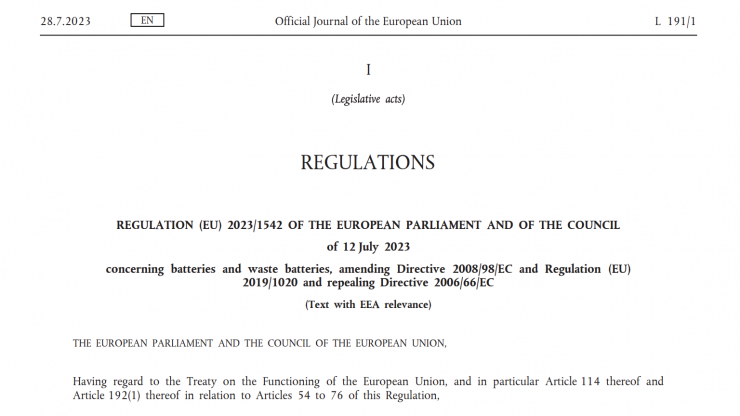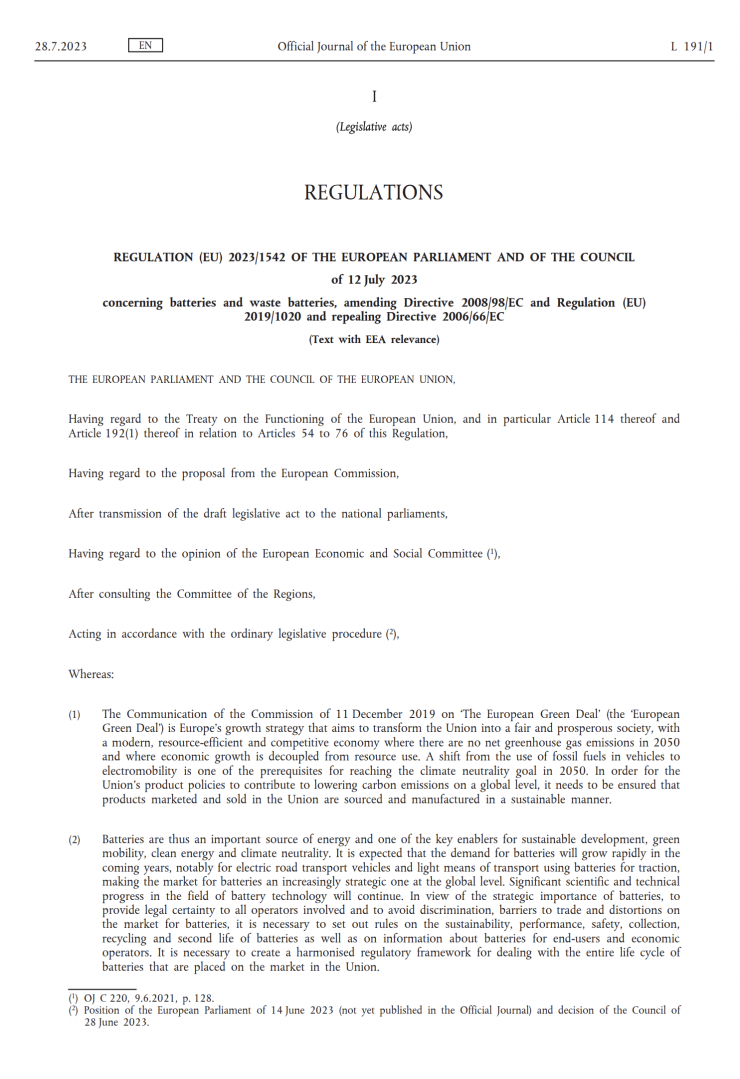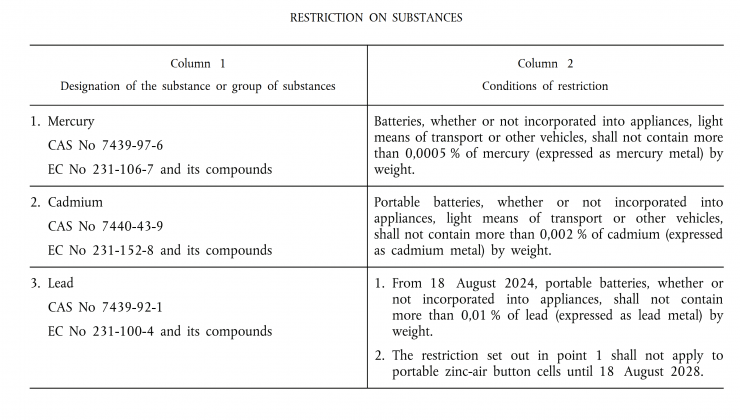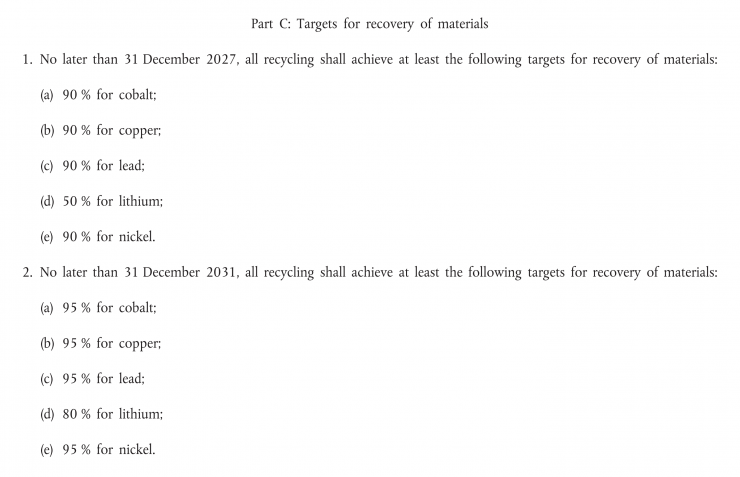
A new EU regulation that was announced in July 2023 will require all batteries in devices to be user-replaceable. The date of this implementation depends on what type of battery it is and what it is used for. Most of the regulations won’t apply till 2027/2028.

Now, while this is mainly aimed at the increase in the number of electric cars that are now on the roads, it also appears to apply to all electronic devices as well. What this essentially means is that anyone making a laptop, smartphone, tablet, light, etc. will have to make that product with a user-replaceable battery.
With so much e-waste being produced, it is, at least in my personal opinion, a good step towards ensuring that devices and batteries can be more easily recycled and have their life extended as the user needs to be able to swap out the batteries themselves.
Background on ‘The European Green Deal’
The Communication of the Commission on ‘The European Green Deal’ (the ‘European Green Deal’) is Europe’s growth strategy that aims to transform the Union into a fair and prosperous society, with a modern, resource-efficient and competitive economy where there are no net greenhouse gas emissions in 2050 and where economic growth is decoupled from resource use.
A shift from the use of fossil fuels in vehicles to electromobility is one of the prerequisites for reaching the climate neutrality goal in 2050. In order for the Union’s product policies to contribute to lowering carbon emissions on a global level, it needs to be ensured that products marketed and sold in the Union are sourced and manufactured in a sustainable manner.
What does this have to do with batteries?
Batteries are an important source of energy and one of the key enablers for sustainable development, green mobility, clean energy and climate neutrality. It is expected that the demand for batteries will grow rapidly in the coming years, notably for electric road transport vehicles and light means of transport using batteries for traction, making the market for batteries an increasingly strategic one at the global level.
In view of the strategic importance of batteries, it is necessary to set out rules on the sustainability, performance, safety, collection, recycling, and second life of batteries. Therefore it is necessary to create a harmonized regulatory framework for dealing with the entire life cycle of batteries that are placed on the market in the Union.
It is also necessary to update Union law on the management of waste batteries and to take measures to protect the environment and human health by preventing or reducing the adverse impacts of the generation and
management of waste, by reducing the impact of resource use and by improving resource efficiency. Such measures are crucial for the transition to a circular and climate-neutral economy and toxic-free environment,
and for the Union’s long-term competitiveness and strategic autonomy.
Directive 2006/66/EC of the European Parliament and of the Council (3) has brought about an improvement in the environmental performance of batteries and established some common rules and obligations for economic
operators, in particular through harmonised rules for the heavy metal content and labeling of batteries and rules and targets for the management of all waste batteries, based on extended producer responsibility.
The Communication of the Commission of 17 May 2018 on ‘Europe on the move – Sustainable Mobility for Europe includes the Strategic Action Plan on Batteries. That action plan sets out measures to support efforts to build a battery value chain in Europe, covering raw materials extraction, sustainable sourcing and processing, sustainable battery materials, cell manufacturing as well as re-use and recycling of batteries.
In its conclusions of 4 October 2019 on ‘More circularity – Transition to a sustainable society’, the Council called for coherent policies supporting the development of technologies that improve the sustainability and
circularity of batteries to accompany the transition to electro-mobility. Furthermore, the Council called for an urgent revision of Directive 2006/66/EC, which should include all relevant battery materials and which should consider, in particular, specific requirements for lithium and cobalt as well as a mechanism allowing the adaptation of that Directive to future changes in battery technologies.
The Communication of the Commission of 11 March 2020 on ‘A new Circular Economy Action Plan – For a cleaner and more competitive Europe’ states that the proposal for a new regulatory framework for batteries will
consider rules on recycled content and measures to improve the collection and recycling rates of all batteries, in order to ensure the recovery of valuable materials and to provide guidance to consumers and will address the possible phasing out of non-rechargeable batteries where alternatives exist. Furthermore, it is stated that sustainability and transparency requirements will be considered, taking into account the carbon footprint of battery manufacturing, the ethical sourcing of raw materials and the security of supply in order to facilitate re-use, repurposing and recycling of batteries.
This Regulation should apply to all categories of batteries placed on the market or put into service within the Union, regardless of whether they were produced in the Union or imported. It should apply regardless of whether a battery is incorporated into appliances, light means of transport or other vehicles or otherwise added to products or whether a battery is placed on the market or put into service within the Union on its own.
This Regulation should apply regardless of whether a battery is specifically designed for a product or is of general use and regardless of whether it is incorporated into a product or is supplied together with or separately from a product in which it is to be used. Placing on the market is considered to take place when the battery has been made available for the first time on the Union market, by being supplied by the manufacturer or importer for
distribution, consumption or use in the course of a commercial activity, whether in return for payment or free of charge. Thus, batteries placed in stock in the Union by distributors, including retailers, wholesalers and sales divisions of manufacturers, before the date of application of relevant requirements of this Regulation do not need to meet those requirements.
Products placed on the market as battery packs, which are batteries or groups of cells that are connected or encapsulated within an outer casing to form a complete unit ready for use by end-users or in applications that
the end-user is not intended to split up or open and which conform to the definition of batteries, or battery cells that conform to the definition of batteries, should be subject to requirements applicable to batteries.
Within the broad scope of this Regulation, it is appropriate to distinguish between different categories of batteries in accordance with their design and use, independently of their battery chemistry. The classification into portable batteries, on the one hand, and industrial batteries and automotive batteries on the other hand under Directive 2006/66/EC should be further developed to better reflect new developments in the use of batteries. Batteries that are used for traction in electric vehicles and which, under Directive 2006/66/EC, fall under the category of industrial batteries, constitute a large and growing part of the market due to the quick growth of electric road transport vehicles. It is therefore appropriate to classify those batteries that are used for traction in road vehicles as a new separate category of electric vehicle batteries. Batteries used for traction in light means of transport, such as e-bikes and e-scooters, were not classified as a separate category of battery under Directive 2006/66/EC. However, such batteries constitute a significant part of the market due to their growing use in urban sustainable mobility. It is therefore appropriate to classify those batteries as a new separate category of batteries, namely light means of transport batteries (LMT batteries). Batteries used for traction in other transport vehicles including rail, waterborne and aviation transport or off-road machinery, continue to fall under the category of industrial batteries under this Regulation. The industrial battery category encompasses a broad group of batteries, intended to be used for industrial activities, communication infrastructure, agricultural activities, or generation
and distribution of electric energy. Batteries which are given industrial uses after being subject to preparation for repurposing or repurposing, even though they were initially designed for a different use, should be considered to be industrial batteries under this Regulation. In addition to this non exhaustive list of examples, any battery that weighs more than 5 kg that does not fall under any other categories under this Regulation should be considered to be an industrial battery. Batteries used for energy storage in private or domestic environments, should be considered to be industrial batteries for the purposes of this Regulation.
Batteries should be designed and manufactured to optimize their performance, durability and safety and to minimize their environmental footprint.
Some non-rechargeable batteries of general use can be inefficient in terms of use of resources and energy. Objective requirements regarding the performance and durability of such batteries should be established in
order to ensure that fewer low performing non-rechargeable portable batteries of general use are placed on the market, in particular, where, based on a life cycle assessment, the alternative use of rechargeable batteries would result in overall environmental benefits. For batteries that are incorporated in mobile phones and tablets it is appropriate to set performance and durability requirements regarding those batteries through a future ecodesign regulation addressing phones and tablets and to update Commission Regulation (EU) No 617/2013 (10) on
computers and computer servers. For other portable batteries that are incorporated in other appliances, such as gardening tools or cordless power tools, the possibility of setting minimum performance and durability
requirements should be addressed in relevant product legal acts, such as implementing acts under Directive 2009/125/EC of the European Parliament and of the Council (11), or in other Union legal act.
Other Key Points
In cases where battery cells or battery modules are made available on the market for end use, without any further incorporation or assembly into larger battery packs or batteries, they shall be considered to have been placed on the market as batteries for the purposes of this Regulation, and the requirements for the most similar battery category shall apply. In cases where it can be considered that such battery cells or battery modules fall under more than one battery category, they shall be deemed to fall under the category to which the strictest requirements apply
‘Battery’ means any device delivering electrical energy generated by direct conversion of chemical energy, having internal or external storage, and consisting of one or more non-rechargeable or rechargeable battery cells, modules, or packs of them, and includes a battery that has been subject to preparation for re-use, preparation for repurposing, repurposing or remanufacturing. ‘Battery pack’ means any set of battery cells or modules that are connected together or encapsulated within an outer casing, to form a complete unit which is not meant to be split up or opened by the end-user;
‘Portable battery’ means a battery that is sealed, weighs 5 kg or less, is not designed specifically for industrial use and is neither an electric vehicle battery, an LMT battery, nor an SLI battery.
A portable battery shall be considered readily removable by the end-user where it can be removed from a product with the use of commercially available tools, without requiring the use of specialized tools, unless provided free of charge with the product, proprietary tools, thermal energy, or solvents to disassemble the product. Any natural or legal person that places on the market products incorporating portable batteries shall ensure that those products are accompanied with instructions and safety information on the use, removal and replacement of the batteries. Those instructions and that safety information shall be made available permanently online, on a publicly available website, in an easily understandable way for end-use.
By 18 August 2026 and at least every five years thereafter, the Commission shall assess whether due to market developments, in particular concerning battery technologies impacting the type of materials recovered and the existing and forecasted availability of cobalt, copper, lead, lithium or nickel or the lack thereof, and in view of technical and scientific progress, it is appropriate to revise the targets for recycling efficiency and recovery of materials set out in Parts B and C of Annex XII. Where justified and appropriate on the basis of that assessment, the Commission is empowered to adopt a delegated act in accordance with Article 89 to amend the targets for recycling efficiency and recovery of materials set out in Parts B and C of Annex XII.







